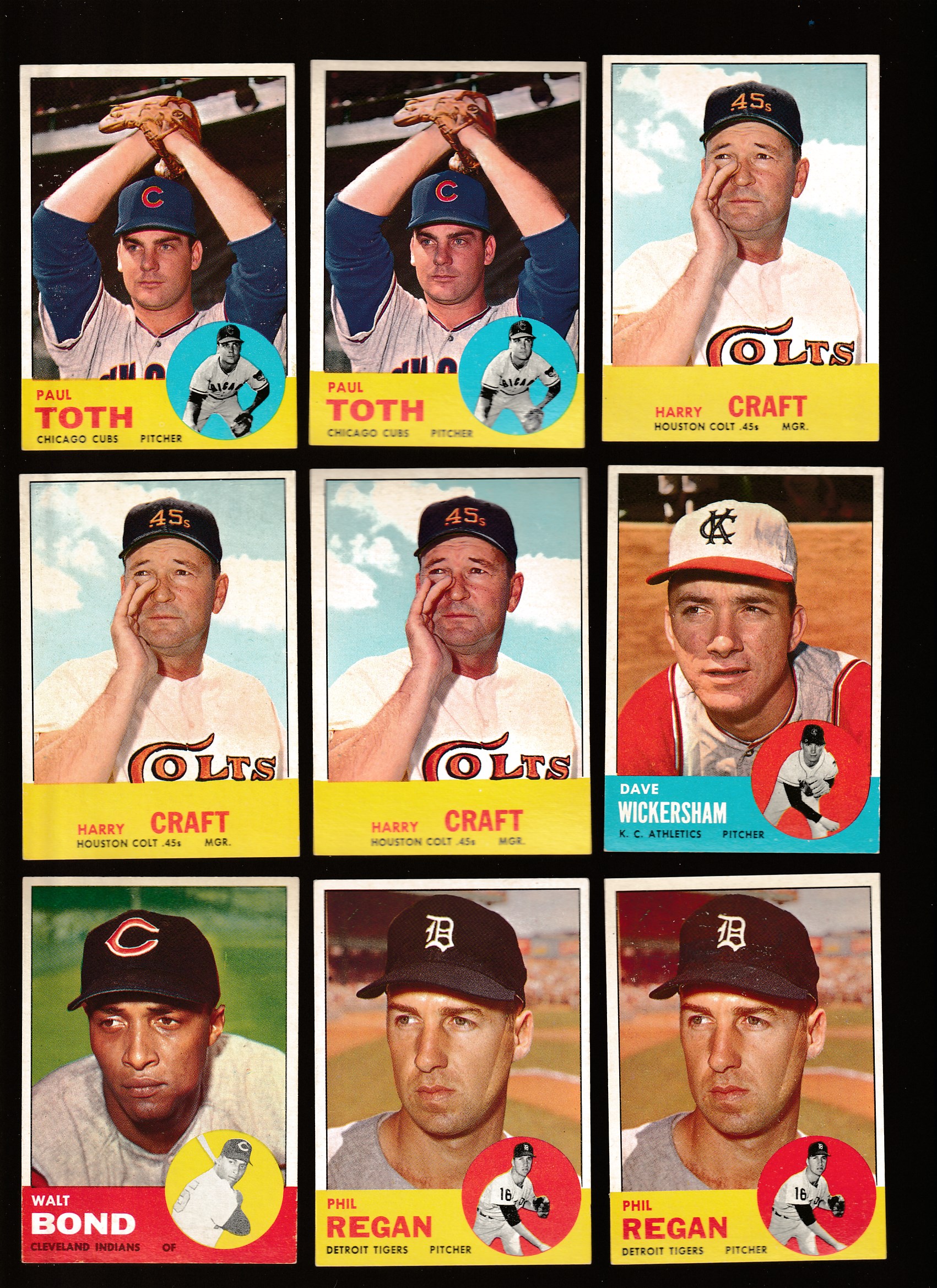Below are short bits & pieces on sportscard & baseball trading card collecting.
Please wander around the website for more info, prices, values & images
on vintage baseball, football, basketball, hockey, sport and non-sports cards.

Vintage Topps 1956 Baseball Cards
Checklist & Prices


1956 Topps were slightly larger (3-3/4" by 2 5/8") horizontal cards
similar to 1955 Topps cards, some even sharing portraits with 1954 and 1955
Topps cards. Team cards & checklists appeared for the first time in 1956.
With Bowman gone, after missing the last 3 years, Mickey Mantle was back !!!
A fun & simple set, 1956 Topps had no high numbers or expensive rookies
but for serious 1956 collectors, there are over 200 variations.
Most variations deal with card stock (gray or white back).
For #101-180 gray appears to outnumber white about 9-to-1.
Many team cards had 2 or 3 variations with team names
Left, Center or Right.


There are 2 great cards: #31 Hank Aaron which actually pictures Willie Mays
sliding home and #135 Mickey Mantle.
Mantle shown leaping high into the stands robbing a home run !
Artist did a great job showing Mantle making the catch !
BUT ... Mantle looked great leaping but the ball flew over his glove.

The 1956 Topps Pins used same portrait photos as the cards.
Click for complete
1956 Topps Pins Checklist and Prices
Click for more info and complete
1956 Topps Baseball card checklist, values and prices.
|

1962 Topps Football Bucks
The 1962 Topps Football Bucks resembled U.S. currency and measured
1 1/4" x 4 1/4". But ... instead of Abe Lincoln staring at you,
it could be Fran Tarkenton !!!
Drawings of the player's home parks along with brief write-ups
appeared on the front. The backs included team and league logos.
Printing was done with black and green ink on off-white
(very thin) paper stock. Bucks are typically found with a fold crease
in the middle as they were inserted in packs in that manner.
The 1962 Topps Bucks were inserts in wax packs of the 1962 Topps regular
issue football cards. Player selection was super and the featured ROOKIES
of Fran Tarkenton and Mike Ditka !!! Also numerous other Hall-of-Famers
including JIM BROWN, BART STARR, Y.A. Tittle, Johnny Unitas, Lou Groza
and other greats !!!
|

Autographed Gateway Cachets

Gateway Stamp Company has provided collectors over 1 MILLION
authenticated certified autographs over the last 30+ years.
Though a "stamp company", Gateway went down a new creative road
combining art, color photographs, historical events & autographs
with their full-color silk cachet envelopes.
WHAT IS A SILK CACHET ?
A "cachet" is a design on an envelope marking an event.
"Silk" refers to the delicate material the art and photography are
printed on after which it's signed by the player and then post-marked by
the Post Office IN THE EVENT'S CITY !!!
WHY POSTMARKS?
A postmark is a great way to mark historical events and the rules
governing postmarks GUARANTEES that NO Gateway issue can EVER be
re-issued protecting their value !!!
Note: You may be on that page right now.
|

Tobacco Cards
Starting approximately in 1886, sportscards, mostly baseball cards, were often
included with tobacco products, for promotional purposes and also because the
card reinforced the packaging and protected cigarettes from damage. These sports
cards are referred to as tobacco cards in the baseball card hobby. Over the next
few years many different companies produced baseball cards. Tobacco cards soon
started to disappear as the American Tobacco Company tried to develop a monopoly
by buying out other companies.
They were reintroduced in the 1900s, as American Tobacco came under pressure from
antitrust action and Turkish competition. The most famous and most expensive,
baseball card is the rare T206 Honus Wagner. The card exists in very limited
quantities compared to others of its type because Wagner forced the card to be
removed from printing. It is widely (and incorrectly) believed that Wagner did
so because he refused to promote tobacco, but the true explanation lies in a
dispute over compensation.
Soon other companies also began producing baseball and football cards. Sports magazines
such as The Sporting News were early entries to the market. Candy manufacturers
soon joined the fray and reflected a shift toward a younger target audience for cards.
Caramel companies were particularly active and baseball cards were one of the first
prizes to be included in Cracker Jacks. World War I soon suppressed baseball card
production.
© 1995-2019 "InterNet's Baseball Card Store" / Joseph Juhasz ... All Rights Reserved
|








